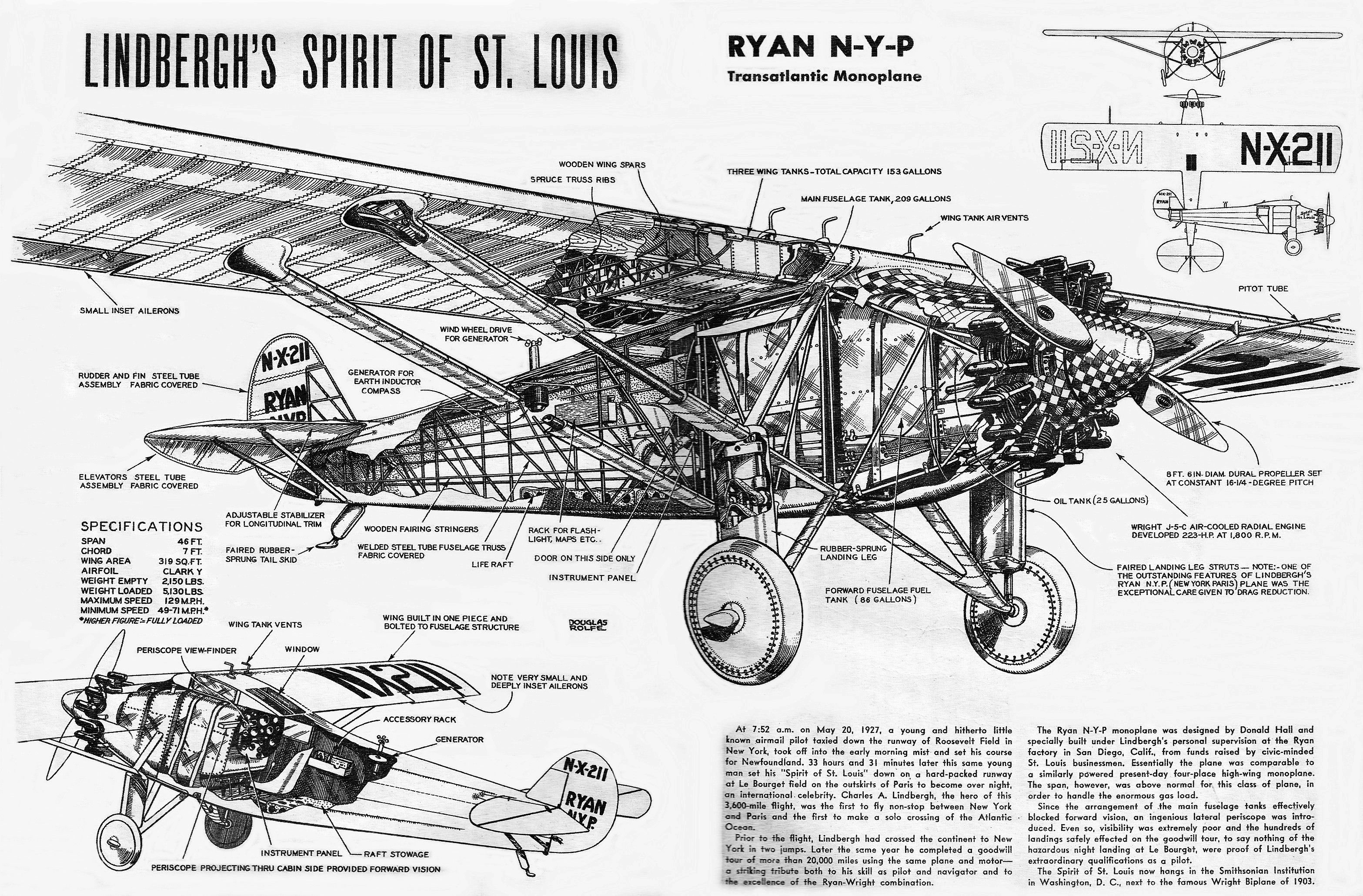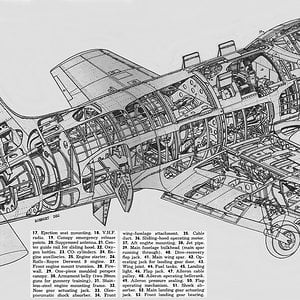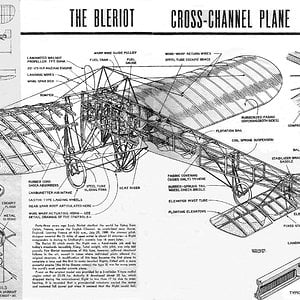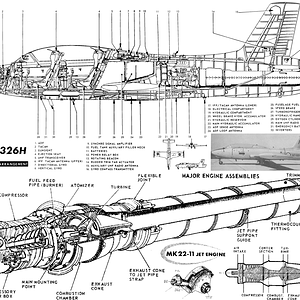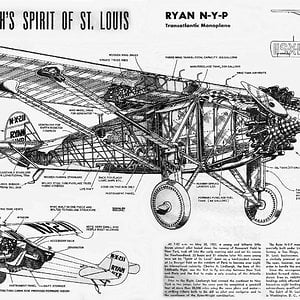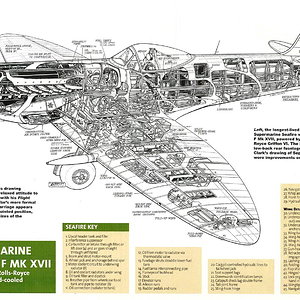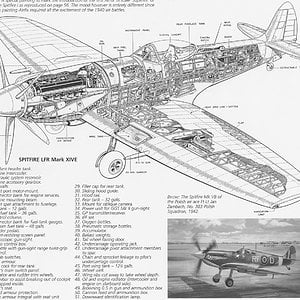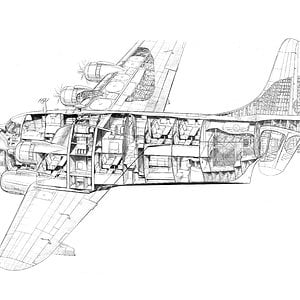Navigation
Install the app
How to install the app on iOS
Follow along with the video below to see how to install our site as a web app on your home screen.
Note: This feature may not be available in some browsers.
More options
You are using an out of date browser. It may not display this or other websites correctly.
You should upgrade or use an alternative browser.
You should upgrade or use an alternative browser.
Lindbergh believed that multiple engines resulted in a greater chance of failure while a single engine design would give him greater range. To increase fuel efficiency, the Spirit of St. Louis was also one of the most advanced and aerodynamically streamlined designs of its era.
Lindbergh believed that a flight made in a single-seat monoplane designed around the dependable Wright J-5C "Whirlwind" radial engine provided the best chance of success. The Ryan NYP had a fuel capacity of 450 U.S. gallons (1,700 L; 370 imp gal) or 2,385 pounds (1,082 kg) which was necessary in order to have the range to make the anticipated flight non-stop. The large main fuel tank was placed in the forward section of the fuselage, in front of the pilot, which improved the center of gravity. While locating fuel tanks at the front reduced the risk of the pilot's being crushed to death in the event of a crash, this design decision also meant that there could be no front windshield, and that forward visibility would be limited to side windows only. A periscope was installed to provide a forward view, as a precaution against hitting ship masts, trees, or structures while flying at low altitude; however, it is unclear whether the periscope was used during the flight. Lindbergh also used special navigation instruments such as the Earth Inductor Compass as its main instrument, allowing Lindbergh to navigate while taking account of the magnetic declination of the earth.
Lindbergh sat in a cramped cockpit which was 94 cm wide, 81 cm long and 130 cm high (36 in × 32 in × 51 in). The cockpit was so small, Lindbergh could not stretch his legs. The Spirit of St. Louis was powered by a 223-horsepower (166 kW), air-cooled, 9-cylinder Wright J-5C "Whirlwind" radial engine. The engine was rated for a maximum operating time of 9,000 hours (more than one year if operated continuously), and had a special mechanism that could keep it clean for the entire New York-to-Paris flight. It was also, for its day, very fuel efficient enabling longer flights carrying less fuel weight for given distances.[N 1] Another key feature of Lindbergh's radial engine was that it was rated to self-lubricate the engine's valves for 40 hours continuously. Lubricating, or "greasing," the moving external engine parts was a necessity most aeronautical engines of the day required to be done manually by the pilot or ground crew prior to every flight and would have been otherwise required somehow to be done during the long flight.[3]
The engine was built at Wright Aeronautical in Paterson, New Jersey by a 24-year old engine builder, Tom Rutledge, who was disappointed that he was assigned to the unknown aviator Charles Lindbergh. Four days after the flight he received a letter of congratulations from the Wright management.[3][N 2] His estate owns pictures of historical interest.[5]
The race to win the Prize required time-saving design compromises. The original wingspan of the Ryan M2 was increased by 10 ft and redesigned to create a surface area large enough to lift 450 U.S. gallons of fuel (carried in five fuel tanks: left wing, right wing, mid wing, nose and in available payload space) along with the lone pilot and minimum necessary gear.
Sample of the treated fabric from the Spirit of St. Louis
However, Donald A. Hall decided that the empennage (tail assembly) and wing control surfaces would not be altered from his original Ryan M-2 design, thus minimizing redesign time that was not available without delaying the flight. The result was less aerodynamic stability; nevertheless the experienced Lindbergh approved the unaltered design.[6] This setup resulted in a negatively stable design that tended to randomly introduce unanticipated pitch, yaw, and bank (roll) elements into its overall flight characteristics. There is dispute regarding whether Hall and Lindbergh also preferred this design because they anticipated that the continuous corrections to the random movements of the aircraft would help to keep Lindbergh awake during the estimated 40-hour flight. Whether or not the unstable design was deliberately retained to help fight fatigue, Lindbergh did later write how these random unanticipated movements helped keep him awake at various times during the flight.[7] The stiff wicker seat in the cockpit was also purposely uncomfortable, though custom fitted to Lindbergh's tall and lanky frame.
Inside of the original propeller spinner of the Spirit of St. Louis
Lindbergh also insisted that unnecessary weight be eliminated, even going so far as to cut the top and bottom off of his flight map. He carried no radio in order to save weight and because the radios of the period would have been unreliable and difficult to use while flying solo. Also, although he was an airmail pilot, he refused to carry souvenir letters on the transatlantic journey, insisting that every spare ounce be devoted to fuel. The fuselage was made of treated fabric over a metal-tube frame, while the wings were made of fabric over a wood frame.
A small, left-facing Indian-style swastika was painted on the inside of the original propeller spinner of the Spirit of St. Louis along with the names of all the Ryan Aircraft Co. employees who designed and built it. It was meant as a message of good luck prior to Lindbergh's solo Atlantic crossing as the symbol was often used as a popular good luck charm with early aviators and others.[N 3] The inside of the original propeller spinner can be viewed at the National Air and Space Museum. This propeller spinner was found to be cracked when Lindbergh arrived at New York prior to his transatlantic flight. The propeller spinner that is on the Spirit of St. Louis now was hastily made in New York to replace the cracked original and was on the plane during the transatlantic flight.
Specifications (Ryan NYP)
Data from [23][N 6]
General characteristics
Crew: One
Length: 27 ft 7 in (8.4 m)
Wingspan: 46 ft (14 m)
Height: 9 ft 10 in (3 m)
Wing area: 320 ft² (29.7 m²)
Airfoil: Clark Y
Empty weight: 2,150 lb (975 kg)
Loaded weight: 2,888 lb (1,310 kg)
Useful load: 450 gal (1,703 l)
Max. takeoff weight: 5,135 lb (2,330 kg)
Powerplant: 1 × Wright Whirlwind J-5C Single blade Standard Steel Propeller, 223 hp (166 kW)
Performance
Maximum speed: 133 mph (220 km/h)
Cruise speed: 100- 110 mph (160-175 km/h)
Range: 4,100 mi (6,600 km)
Service ceiling: 16,400 ft (5,000 m)
Rate of climb: Considered[24] ()
Wing loading: 16 lb/ft² (78 kg/m²)
Power/mass: 23 lb/hp (10.4 kg/hp)
Lindbergh believed that a flight made in a single-seat monoplane designed around the dependable Wright J-5C "Whirlwind" radial engine provided the best chance of success. The Ryan NYP had a fuel capacity of 450 U.S. gallons (1,700 L; 370 imp gal) or 2,385 pounds (1,082 kg) which was necessary in order to have the range to make the anticipated flight non-stop. The large main fuel tank was placed in the forward section of the fuselage, in front of the pilot, which improved the center of gravity. While locating fuel tanks at the front reduced the risk of the pilot's being crushed to death in the event of a crash, this design decision also meant that there could be no front windshield, and that forward visibility would be limited to side windows only. A periscope was installed to provide a forward view, as a precaution against hitting ship masts, trees, or structures while flying at low altitude; however, it is unclear whether the periscope was used during the flight. Lindbergh also used special navigation instruments such as the Earth Inductor Compass as its main instrument, allowing Lindbergh to navigate while taking account of the magnetic declination of the earth.
Lindbergh sat in a cramped cockpit which was 94 cm wide, 81 cm long and 130 cm high (36 in × 32 in × 51 in). The cockpit was so small, Lindbergh could not stretch his legs. The Spirit of St. Louis was powered by a 223-horsepower (166 kW), air-cooled, 9-cylinder Wright J-5C "Whirlwind" radial engine. The engine was rated for a maximum operating time of 9,000 hours (more than one year if operated continuously), and had a special mechanism that could keep it clean for the entire New York-to-Paris flight. It was also, for its day, very fuel efficient enabling longer flights carrying less fuel weight for given distances.[N 1] Another key feature of Lindbergh's radial engine was that it was rated to self-lubricate the engine's valves for 40 hours continuously. Lubricating, or "greasing," the moving external engine parts was a necessity most aeronautical engines of the day required to be done manually by the pilot or ground crew prior to every flight and would have been otherwise required somehow to be done during the long flight.[3]
The engine was built at Wright Aeronautical in Paterson, New Jersey by a 24-year old engine builder, Tom Rutledge, who was disappointed that he was assigned to the unknown aviator Charles Lindbergh. Four days after the flight he received a letter of congratulations from the Wright management.[3][N 2] His estate owns pictures of historical interest.[5]
The race to win the Prize required time-saving design compromises. The original wingspan of the Ryan M2 was increased by 10 ft and redesigned to create a surface area large enough to lift 450 U.S. gallons of fuel (carried in five fuel tanks: left wing, right wing, mid wing, nose and in available payload space) along with the lone pilot and minimum necessary gear.
Sample of the treated fabric from the Spirit of St. Louis
However, Donald A. Hall decided that the empennage (tail assembly) and wing control surfaces would not be altered from his original Ryan M-2 design, thus minimizing redesign time that was not available without delaying the flight. The result was less aerodynamic stability; nevertheless the experienced Lindbergh approved the unaltered design.[6] This setup resulted in a negatively stable design that tended to randomly introduce unanticipated pitch, yaw, and bank (roll) elements into its overall flight characteristics. There is dispute regarding whether Hall and Lindbergh also preferred this design because they anticipated that the continuous corrections to the random movements of the aircraft would help to keep Lindbergh awake during the estimated 40-hour flight. Whether or not the unstable design was deliberately retained to help fight fatigue, Lindbergh did later write how these random unanticipated movements helped keep him awake at various times during the flight.[7] The stiff wicker seat in the cockpit was also purposely uncomfortable, though custom fitted to Lindbergh's tall and lanky frame.
Inside of the original propeller spinner of the Spirit of St. Louis
Lindbergh also insisted that unnecessary weight be eliminated, even going so far as to cut the top and bottom off of his flight map. He carried no radio in order to save weight and because the radios of the period would have been unreliable and difficult to use while flying solo. Also, although he was an airmail pilot, he refused to carry souvenir letters on the transatlantic journey, insisting that every spare ounce be devoted to fuel. The fuselage was made of treated fabric over a metal-tube frame, while the wings were made of fabric over a wood frame.
A small, left-facing Indian-style swastika was painted on the inside of the original propeller spinner of the Spirit of St. Louis along with the names of all the Ryan Aircraft Co. employees who designed and built it. It was meant as a message of good luck prior to Lindbergh's solo Atlantic crossing as the symbol was often used as a popular good luck charm with early aviators and others.[N 3] The inside of the original propeller spinner can be viewed at the National Air and Space Museum. This propeller spinner was found to be cracked when Lindbergh arrived at New York prior to his transatlantic flight. The propeller spinner that is on the Spirit of St. Louis now was hastily made in New York to replace the cracked original and was on the plane during the transatlantic flight.
Specifications (Ryan NYP)
Data from [23][N 6]
General characteristics
Crew: One
Length: 27 ft 7 in (8.4 m)
Wingspan: 46 ft (14 m)
Height: 9 ft 10 in (3 m)
Wing area: 320 ft² (29.7 m²)
Airfoil: Clark Y
Empty weight: 2,150 lb (975 kg)
Loaded weight: 2,888 lb (1,310 kg)
Useful load: 450 gal (1,703 l)
Max. takeoff weight: 5,135 lb (2,330 kg)
Powerplant: 1 × Wright Whirlwind J-5C Single blade Standard Steel Propeller, 223 hp (166 kW)
Performance
Maximum speed: 133 mph (220 km/h)
Cruise speed: 100- 110 mph (160-175 km/h)
Range: 4,100 mi (6,600 km)
Service ceiling: 16,400 ft (5,000 m)
Rate of climb: Considered[24] ()
Wing loading: 16 lb/ft² (78 kg/m²)
Power/mass: 23 lb/hp (10.4 kg/hp)

